You might ask yourself why a fishing rig is needed to catch perch. The truth is, it’s not. Small perch (less then 1 lb) are abundant in most freshwater lakes and pretty easy to catch with a fishing line, #5-8 Aberdeen or J hook, and a worm. However, larger perch in the 1 to 2 pound range are a bit more challenging to hook. Catching larger perch requires skill and the right presentation of bait or lure. This is where a perch rig gets really useful.
If you’re goal is to catch your limit of perch, or reel in a giant trophy perch, then using a perch rig will improve your chances of reaching your limit and landing a of those jumbo perch out there.
Below we’ll introduce you to some of the most effective fishing rigs for catching perch, and discuss which rigs are best suited for various fishing habitat and conditions.
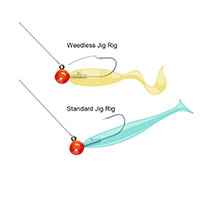
Creates a jerky, vertical motion to attract feeding fresh and saltwater fish
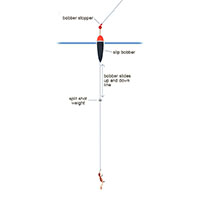
Can be fished at various depth with an easy adjustment to a bobber stop
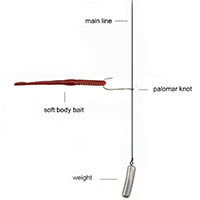
A bass fishing rig that can be fished deep, shallow, and anywhere in between
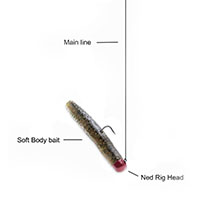
Ideal for fishing tough conditions. Small profile and mimics natural food source
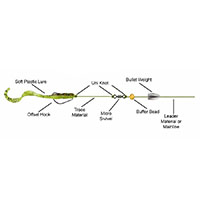
Used for casting and dragging across a target area where fish may be located
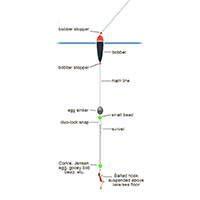
One of the most traditional and effective rigs for catching a large variety of fish
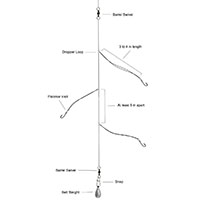
A versatile multi-hooked bottom fishing rig use for bottom fishing and surf fishing

Bottom fishing rig for walleye, bass, trout and catfish feeding near the bottom
Jig Rigs for Perch
A good ‘ol jig rig is about as easy and effective as it gets for hooking perch. You can fish a jig in just about any water conditions, and with the right lure and action you’ll be reeling in perch about as fast as you can get your line in the water—at least in some lakes.
Your basic jig rig for perch fishing includes a 2 to 8 lb test fluorocarbon line, depending on lure size and fishing style. For the smallest lures, a 2 lb test is sufficient. For still-fishing or casting, a 4 to 6 lb test is recommended, and for slow trolling most anglers will take their line size up to about an 8 lb test.
For the basic setup add a standard or weedless 1-3 gram jighead with a soft plastic worm, grub or minnow to the end of the line. A good soft plastic should create irresistible action. This rig can be baited with live worms, grubs, or minnows, but artificials will catch plenty of perch and are much more durable than bait.
A variation of the jig rig—the light spinning perch jig setup—which is used on a fixed spool reel is designed to cast lighter lures a longer distance, yet manage heavier lures as well. This is a versatile jig rig setup good for targeting both small and larger perch at a distance.
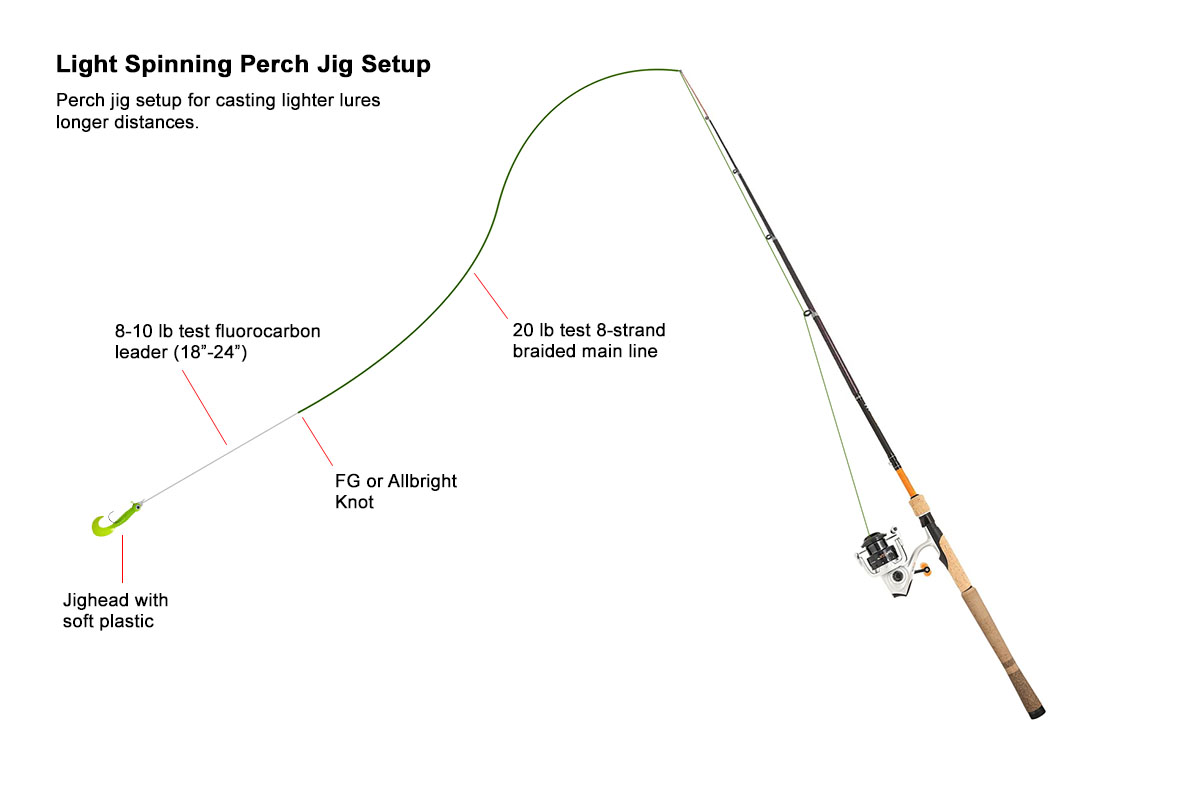
The light spinning perch jig rig setup uses a heavier 20 lb test 8-strand braid for the main line with a 10 lb test attached to a 18-24″ fluorocarbon leader. To ensure the leader passes through th line guides while casting, attach main line to leader using an Allbright of FG knot. Lure options for this configuration are the same as those for the basic setup, but you can also use slightly heavier lures.
The jig rig can be fished using spinning gear or with a baitcaster, but spinning gear is usually the best option if your just getting started. Baitcaster work great for casting light lures if you know how to use one.
A good perch jig rod for either the basic or light spinning setup is 5’6″ to 7′ light (or ultralight) spinning rod. A drop-shotting style rod is ideal for perch fishing. It’s got plenty of backbone for handling larger perch combined with an ultra sensitive tip that imparts life like action to the lure and allows the angler to sense even the smallest bites.
The jig rig reel for perch fishing we recommended is a front-drag fixed-spook reel in the 2500 size range for your 6-7′ rods, and maybe something smaller like a 1000 if you’re fishing small rigs on a shorter 5′-6′ rod.
Slip Bobber Rig
Just about on par with jig rigs for ease and effectiveness of catching perch is the slip bobber rig. Slip-bobbers are all around great panfish rigs, and they work equally as well for catching white and yellow perch.
We’ve found the slip bobber rig works particularly well during later summer, or any other time, when panfish—perch included—tend to congregate and hold in deeper water. Once you know where perch are holding, the adjustable bobber stop on the rig allows you to set your presentation to the specific depth where fish are holding, which is bit more challenging when using a set slip float cast.
What really sets the slip bobber apart from a fixed depth set float, or comparable rig, is casting. Whether your rig is set for a depth of 5 feet or 15 feet, casting with a slip bobber is a cinch. When you’re ready to cast, the bobber slides down to the lure or weight. With a set float rig, it can be difficult to cast if the bobber is more than 3 feet from the bait. It’s casting ability makes the slip bobber an excellent rig to target perch from the bank.
Drop Shot
Dropshotting is a finesse method for fishing perch using a soft plastic bait. The drop shot rig is traditionally used for targeting bass, but also offers several advantages for fishing perch. It provides great control, but more importantly it allows you suspend your lure at any depth in the water column. It’s also a great presentation to use when perch are getting wise to chasing jigs.
A drop shot rig for fishing perch is almost identical to a drop shot for fishing bass. To account for the smaller mouth of the perch, just make sure to downsize your hook. A #4-8 hook with a weight in the range of 1/8 to 1/4 oz is a perfect configuration for most perch.
One of the keys to the drop shot presentation is ensuring the hook remains at a 90% angel (perpendicular) to the line and point up in the water. To accomplish this, start by threading your line through the underside of the hook. Position the hook where you want it on the line then fasten it in place using the dropper look knot.
Fishing a drop shot to catch perch involves a simple technique. Once the weight is on the bottom, jiggle your rod tip to impart some action to the lure. The twitches and lifts of the lure will attract passerbyer perch and entice them to strike.



